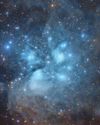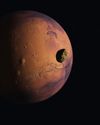Try GOLD - Free
Arecibo Observatory
All About Space
|Issue 112
Prior to its decommissioning and sudden collapse, this huge dish made many invaluable contributions to astronomy
-

THE SPECS
Dish diameter: 305 metres (1,000 feet)
Curvature radius: 265 metres (870 feet)
Number of panels: 38,778
Transmission power: 20TW at 2380MHz
Receiver weight: 900 tonnes
Receiver height: 150 metres (492 feet)
Official opening: 1 November 1963
Decommission order: 19 November 2020
Welcome to the National Astronomy and Ionosphere Center, better known as the Arecibo Observatory. The observatory’s 305-metre (1,000foot) radio telescope dish was completed in 1963, but in November 2020 it was flagged for decommissioning and eventual demolition.
Until 2016 it was the world’s largest singleaperture telescope, and it was involved in many exciting radio astronomy discoveries, as well as collecting data in an attempt to detect alien life. It appeared in many films, video games and TV shows and once boasted a visitor centre that welcomed nearly 100,000 visitors a year.
Nestled in the rainforest of Puerto Rico inside a depression left by a sinkhole, the huge dish antenna has its roots in a 1950s missile defence program. The problem was that incoming nuclear weapons could drop radar decoys as they reentered the atmosphere, making it impossible to tell which were real and which were decoys. By studying the upper levels of the atmosphere it was hoped enough knowledge could be gleaned to tell the bombs from the duds. Early in its life, the telescope also helped locate Soviet radar installations by detecting their signals bouncing off the Moon.
This story is from the Issue 112 edition of All About Space.
Subscribe to Magzter GOLD to access thousands of curated premium stories, and 10,000+ magazines and newspapers.
Already a subscriber? Sign In
MORE STORIES FROM All About Space

All About Space UK
MYSTERIES OF THE UNI WHERE ARE ALL THE SPIRAL GALAXIES?
There are far fewer spiral galaxies than elliptical ones in the Supergalactic Plane, and scientists are keen to discover why
7 mins
Issue 161

All About Space UK
ZOMBIE STARS
+10 OTHER TERRIFYING SPACE OBJECTS
8 mins
Issue 161

All About Space UK
HOW TO BEAT LIGHT POLLUTION
Thought it was impossible to observe the wonders of the night sky from towns and cities? Think again. Follow our tips and tricks on successfully observing through sky glow
2 mins
Issue 161

All About Space UK
15 STUNNING STAR CLUSTERS
These beautiful stellar groupings are spattered across the cosmos
8 mins
Issue 161

All About Space UK
Eileen Collins "It was a difficult mission...we were the first to see Mir"
Having served as both the first female pilot and first female commander of NASA's Space Shuttle, Collins boosted the involvement of women in space exploration to a whole new level
9 mins
Issue 161

All About Space UK
MARS LEAKS FASTER WHEN IT'S CLOSER TO THE SUN
The Red Planet has lost enough water to space to form a global ocean hundreds of kilometres deep
2 mins
Issue 161

All About Space UK
FUTURE TECH KANKOH-MARU
This ambitious reusable spacecraft will be capable of taking 50 people to and from orbit
2 mins
Issue 161

All About Space UK
THE FINAL FRONTIER
Beyond the reach of the Sun is a fascinating region of the cosmos that were only just beginning to explore
8 mins
Issue 161

All About Space UK
A long-lost moon could explain Mars' weird shape and extreme terrain
A long-lost moon could explain why Mars is so different from the other rocky planets in the Solar System. Today Mars has two tiny moons.
2 mins
Issue 161

All About Space UK
A sprinkling of cosmic dust may have helped kick-start life on Earth
Cosmic dust may have helped kick-start life on Earth. New findings challenge a widely held assumption that this wasn't a plausible explanation.
3 mins
Issue 161
Translate
Change font size

